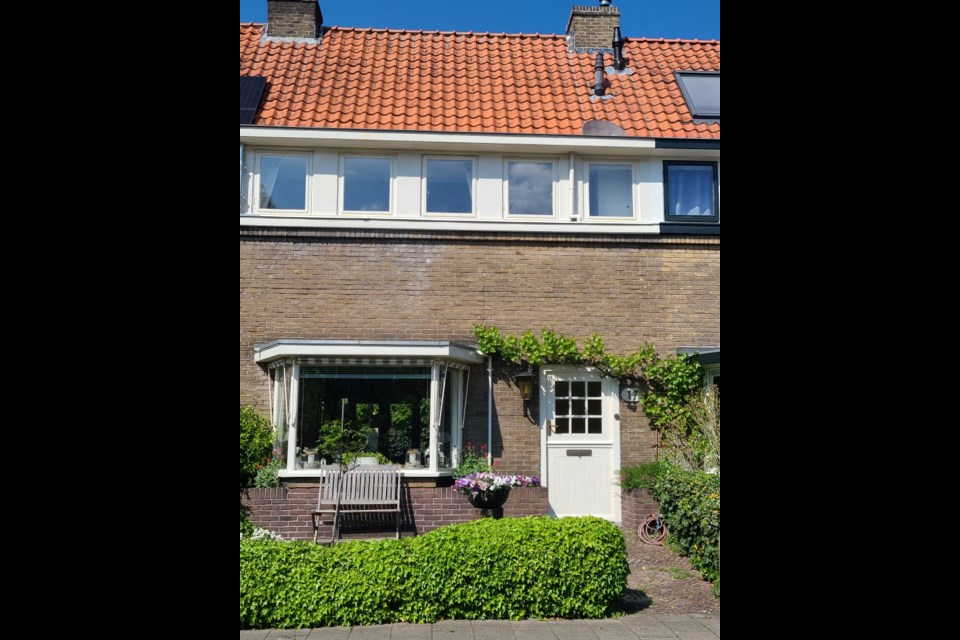MOOSE JAW — Three Moose Jaw-area women who travelled to the Netherlands to honour their veteran fathers are reflecting on how emotional the pilgrimage was and what it meant to walk that “sacred” ground.
Carole Nelson, from Moose Jaw, Lana Hebert, from Moose Jaw, and Joanne Haig, from Rouleau, visited the Western European country recently with the group “In Our Fathers’ Footsteps” to commemorate the 80th anniversary of the Dutch liberation and the end of the Second World War.
On the march
Haig said the tour was well-organized and exceeded her expectations. They attended 22 ceremonies — Canada’s Governor General was at one — and parades, walked 20 kilometres to emulate the soldiers, visited the four main Canadian war cemeteries and appreciated how the Dutch people welcomed them with open arms.
The Rouleau resident said emotionally that it “definitely was” worth it to walk where her father, Joseph A. Braconnier, fought. The tour shed more light on his activities, which was helpful since Braconnier didn’t say much about his experiences.
Before the tour began, Haig and Hebert visited the community of Hilversum. There, they searched for the home of Joanne and Gerry Aalders, who housed their fathers — they helped celebrate Braconnier’s 21st birthday — during the war.
The Aalders later sold their home and moved to New Zealand in 1974.
Two Dutch women had to point the two Saskatchewan women toward the house because the latter’s GPS device malfunctioned. Haig said it “was awesome” to find the home, but the owners weren’t around because it was a holiday. So, she and Hebert peeked through the windows and took a picture of themselves outside.
The friends then joined up with the 132 other tour participants the next day.
Pilgrimage of remembrance
“I don’t call it a trip, I call it a pilgrimage, because in reality, that’s what it really was,” said Hebert.
It was incredible to walk in the footsteps of one’s father and understand the sacrifice that many young men made, and to experience the reverence that the Dutch people have for every soldier, she continued.
“We almost felt guilty — we did feel guilty — because they kept thanking us … ,” Hebert remarked. “Eighty years later and these people have just not forgotten.”
Hebert’s father was John Kenneth (JK) Budge, who served with Braconnier in the 10th Infantry Brigade in the 4th Armoured Division. She said she felt his presence on the trip “over and over and over.”
The group spent much time speaking with seniors everywhere, while there were “constant tears” during the conversations, said Hebert. There were many sacred moments, while every day was emotional.
Canadians have a poor grasp of the war’s carnage because they weren’t conscripted — or worked to death — to build bunkers for the Germans, nor do they dig up bombs in their backyards, Hebert continued. Conversely, the Dutch have those connections, which is why they remember.
The Moose Javian described the battlefields as “sacred” because of the Allied soldiers’ sacrifices and how “there is blood in that ground.” They had to “hang tough” in the face of difficulty, which is not something Canadians face today.
During the final day in Holland, a senior bought Hebert and Haig ice cream and then emotionally told them how much he and the Dutch people owed them for their freedom. This act, she noted, was deeply moving.
The trip was ‘so worth it’
“It was fantastic,” said Nelson, who honoured her father, WTE Finan, who served in the 12th Army Tank Battalion (The Three Rivers (Trois Rivieres) Regiment).
Nelson described the trip as emotional, educational and enlightening. She was particularly impressed with the group’s historians and the knowledge they imparted along the journey.
The tour started in southwest Holland in the Scheldt, a location of intense fighting between the Germans and Canadians, she recalled.
The Germans levelled the area and flooded the fields to hamper the Allies’ efforts. These actions prevented Dutch farmers from growing crops for 15 years, while residents were forced to replant trees and rebuild communities; the oldest tree and community in that area is only 65 years old.
“… the devastation was astounding,” said Nelson.
Nelson recalled a story of soldiers — forward observation officers (FOOs) — using church steeples to call down artillery fire on the Germans. During one visit, she learned that a Canadian FOO had written his name and his unit’s name on a beam in a steeple. Decades later, parishioners came across those names when replacing the steeple’s beams and kept that one piece.
Nelson also recalled that her sister’s friend’s father was a FOO who was caught behind enemy lines. He survived thanks to a little boy bringing him food and water at night. Her sister’s friend met the boy — now an old man — and his children.
“It was phenomenal,” she remarked.
Another highlight for Nelson was how well the Dutch — especially the children — celebrated their liberation and the respect they paid to the veterans and the veterans’ descendants. She noted that these efforts made Canada’s Remembrance Day ceremonies “look pitiful” since the day has become a “quasi-holiday.”
Meanwhile, Nelson’s sister took along pages from their father’s scrapbook, including a map that showed his unit’s movements in Italy and Northwest Europe. She recalled that the group’s military personnel had never seen such a map before and stayed up all night reviewing it and excitedly emailing colleagues in Canada.
“And with it, there were pictures my dad had taken during the war. God knows how he got a camera and film while he was doing battle, but he did,” said Nelson, noting the Royal Canadian Dragoons Museum in Oshawa, Ont., has agreed to take her father’s military things.
“We didn’t know about any of that (information about the pictures), so it was quite a surprise,” she added. “(But attending the tour) was so worth it, so worth it.”




